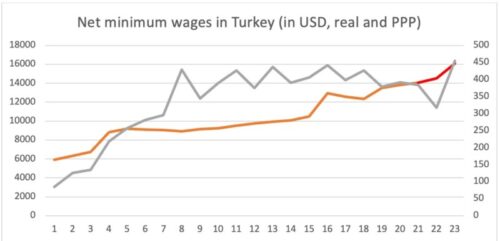T
he net minimum wage in Turkey will be raised to TRY 8,506 or USD 455 in today’s exchange rate. Gross minimum wage, on the other hand, will rise to USD 536 (corresponding to TRY 10,008). This is the highest minimum wage in the history of the modern Turkish Republic, both in Turkish lira and the U.S. dollars.
This wage floor surge also corresponds to a cumulative 100 percent increase in the past one year, as opposed to the year-end 65 percent expected inflation by the Turkish Central Bank. The new minimum wage is above the hunger threshold set by TÜRK-İŞ, the confederation of Turkish trade unions, and above the official market expectation of close to TRY 8,000.
Overall, with the current record rise of 55 percent, the minimum wage has gone up from TRY 184 in 2001 to TRY 8,506 (46 times the initial value) in the past 20-22 years. In U.S. dollar-denominated terms, the minimum wage is up by 430 percent.
Meanwhile, for a more realistic comparison, the U.S. dollar inflation and cross-country price differences should also be taken into account. Minimum wages in real dollar terms and USD Purchasing Power Parties (PPP ) are also provided in the figure above (Figure 1). They also confirm the rising PPP-based, real U.S. dollar terms of minimum wages in Turkey.
Asymmetric income flow
Even at its current all-time high, the minimum wage adjustment itself is clearly not sufficient to enhance the standards of living. Minimum wage to average or median wage ratios is over 70 percent nowadays, and they need to be decreased to the modern world averages of 40 to 50 percentage points.
Moreover, the ratio of laborers that are paid somewhere close to the minimum wage is around 38 percent in Turkey, or more than 7 million employees. This statistic needs to be decreased to somewhere close to 10 percent, closer to its modern western and OECD averages. That said, it is of course not the Turkish government to blame for these disruptive figures which are more related to the long-skewed dynamics of the Turkish economy and its real sector.
Another example of the skewed and distorted income equality in Turkey is the fact that in 2011, on average, wages and salaries were 21 percent of the total cost in the balance sheet of an average company. In the manufacturing sector that figure was down to 15 percent. In 2020, the year which saw the outbreak of the COVID-19 pandemic, the share was further down to 9 percent of total costs.
As of 2022, on the other hand, these figures are down to a few percentage points for some major businesses in Turkey. That is, indeed, part of the reason why the 2022 income flows are surging for companies in Turkey. As a result, profits and dividend expectations are also rising, which in return increases demand and prices of stocks.
For some major Turkish companies, before tax profits are up from 5-7 percentage points to 9-10 in the past five years. In some sectors in Turkey, 2022 profits are even up by 400 percent. Banking is just one recent popular example. While the share of wages and income for employees is hovering around 26 percent of national income, companies are enjoying somewhere close to 55 percent of the total national income.
The pandemic of 2020 was a breaking point for this figure, as just before 2020, the labor share was above 30 percent and company shares were below 50 percent of the national income. Right before the coup attempt in 2016, business shares were even down to almost 42 percent, while back then labor stood at almost 32 percent of the national income.
Does a higher minimum wage really work?
However, the true question is whether a higher minimum wage really works. There is, after all, a general public and theory-based academic perception that minimum wages don’t actually work, and that they could even lead to unemployment or inflation, as critics argue some companies won’t be able to pay those higher wages.
And, of course, then there are also these two popular neoclassical criticisms: that higher minimum wages will raise price levels and increase unemployment. So, is there any truth to these claims? Does the existence of a minimum wage really lead to unemployment? Or, should the market decide on wages and payments?
Theoretical and ad-hoc supply and demand analysis also shows potential negative impacts. This approach argues that the higher costs of production may force some companies (that are not able to increase their prices instantly) to lay off workers as in the case of other negative supply shocks such as an energy crisis.
However, there is an extensive literature based on empirical studies showing the opposite. As in the popular Sraffa, Reich, and Card and Krueger examples, literature provides empirical data from the U.S. and many European economies testifying to no negative impacts on employment by higher minimum wages.
The idea is that due to their flexible or monopsonistic nature, labor markets are rather complex. A reasonable minimum wage could even increase employment, for instance. Meanwhile, higher minimum wages could also decrease training costs by decreasing turnover rates.
Nowadays, consensus is rather about rising unemployment amongst low-skilled workers. Most of the empirical findings on negative impacts on unemployment are again related to low-skilled workers or the tradable sectors. Though, these workers could indeed be supported by supplementary programs such as a family support system or other unemployment reliefs.
Higher minimum wages could also increase cost-push inflation (PPI). At least in the short run, wage increases are likely to increase costs of production. Yet, regulatory measures could be used to limit even these price increases. Meanwhile, the TEM (Turkish Economy Model) is actually supporting businesses and mitigating these types of inflationary effects.
The demand-pull inflation may also be brought up, but it is still not that common in newly rising economies such as Turkey. The argument is that increasing purchasing power (following rising wages and salaries) and higher demand are additional factors that could lead to higher prices. Both these factors can lead to demand-pull inflation, especially in the advanced economies.
Another issue, at this point, is that in developing or newly rising economies such as Turkey, it is rather more difficult to assume that all the income increases will lead to instant demand explosions. Bequest or intergenerational transfer motives should also be taken into account.
These type of wage adjustments are surely needed in order to avoid the declining purchasing power, economic contraction, and the resulting potential negative impacts on labor markets and employment. Rising purchasing power and increasing demand, on the other hand, could even potentially lead to higher production and employment.
Policies such as a minimum wage limit would also help deal with race, gender, and ethnic-background related discrimination. As rightly pointed by Saez, Zucman and Piketty, among others, minimum wage debates are also directly related to the fight against these rising inequalities, fairness, and increasing labor income share in national income.
Recommended
Concluding thoughts
In an ideal world and a fair business environment, minimum wages could be abolished. The market would set the proper wages that balance the needs of employees and the budget of employers. However, that ideal world is very far away from reality. By today’s standards, no business would be willing to pay an extra penny.
In Turkey, for instance, around 38 percent of employees are still paid close to the minimum wage. Even in the profit-booming year of 2022, over 7 million workers have been paid approximately the minimum legal wage. On the other hand, firm sales, profits, and hence the resulting stock prices are all soaring nowadays.
Moreover, higher minimum wages, supported by the public, are also in line with the TEM that focuses on more investment, production, employment and export, as well as a lower CA deficit. Thanks to the TEM, the total employment figure is nowadays up to 31.6 million people, the highest in modern Turkish history. Meanwhile, unemployment rate is down to 10 percent, despite the rising labor force participation rate of 52 percent.
That said, while conjunctural inflationary disruptions are being replaced with minimum wage adjustments, they should not lead to new disruptions and distress. That is why companies and employees should both be considered, alongside their resilience and financial circumstances.
The minimum wage will probably remain a critical policy issue in the near future as well. However, it is time now to focus and think beyond that. The world is moving towards new trends, such as a universal basic income and family support systems, to ensure minimum income for families. The only issue left today is to unravel the complexity of the tale linking minimum wage, income inequality, and unemployment.






